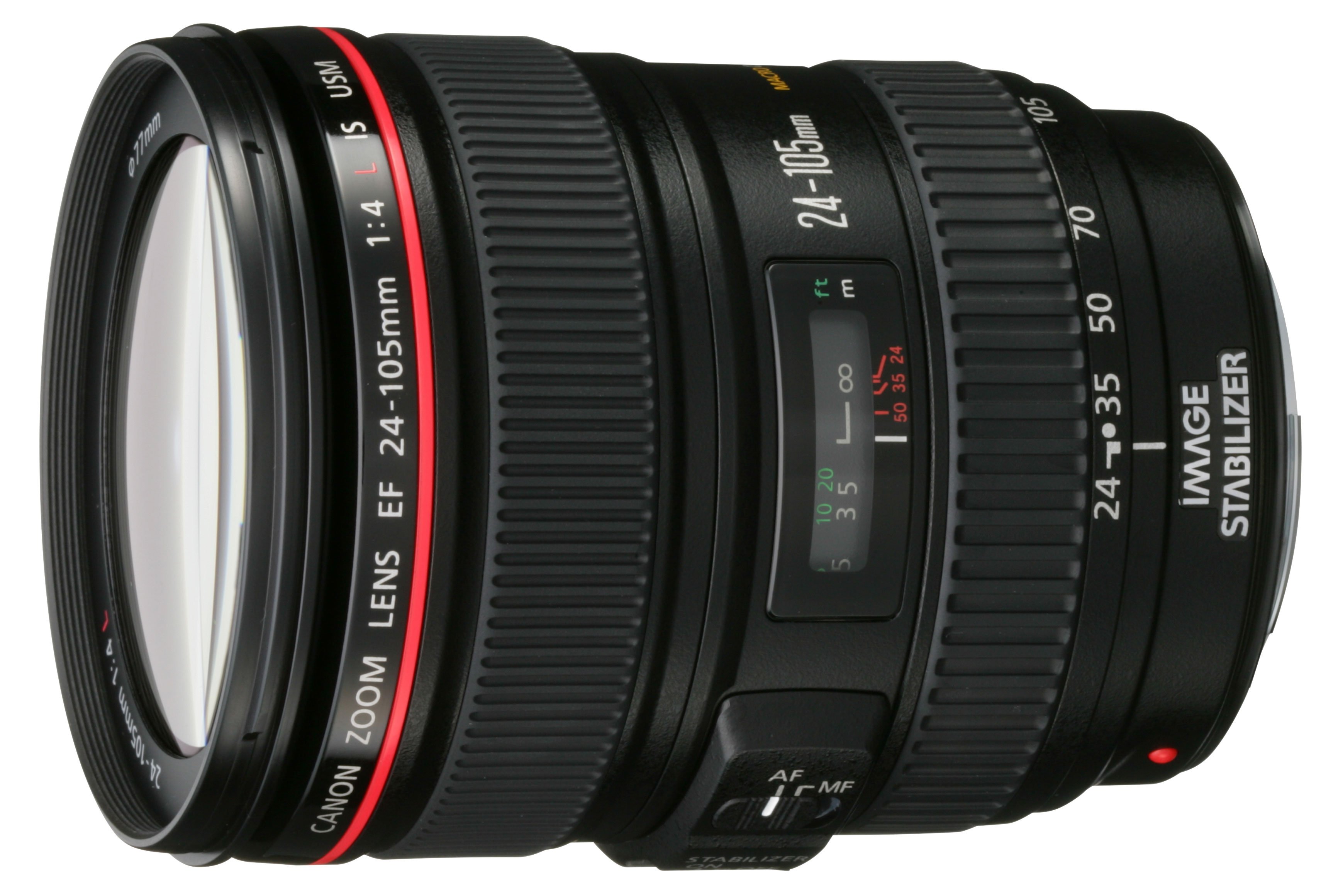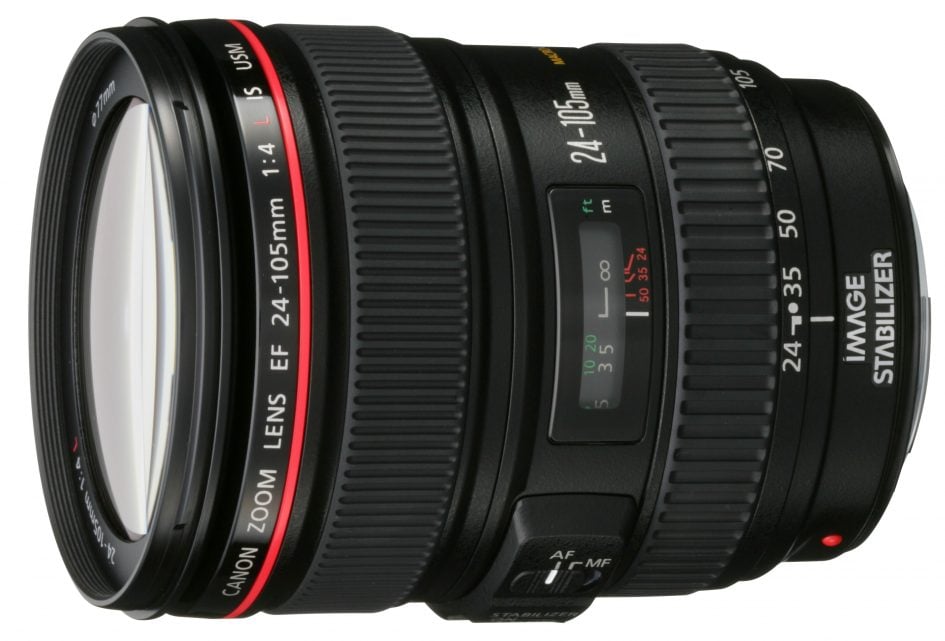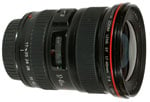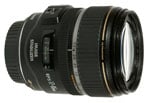
Canon EF 24-105mm f/4L IS USM, (tested with cropped-frame APS-C body)
-
-
Written by Gordon Laing
Verdict
Canon EF 24-105mm for cropped-frame verdict
There’s no denying the Canon EF 24-105mm is a high quality lens. It has decent optics, the excellent mechanical and build quality you’d expect from Canon’s L series, while the USM auto-focusing and Image Stabilisation are both very effective in use.
Mounted on a full-frame body like the EOS 5D, the EF 24-105mm is an ideal general-purpose zoom lens for those who demand high quality, but how suitable is it on a cropped-frame body like the EOS 400D / XTi, EOS 450D / XSi and EOS 40D?

The build quality, mechanical performance, constant f4 aperture, focusing and stabilisation remain equally effective and applicable on cropped-frame bodies, but the range is of course very different. On a full-frame body, the EF 24-105mm takes you from decent wide-angle to short telephoto, whereas with the 1.6x field reduction of cropped frame, the range is transformed into a far less exciting 38-168mm. This takes you from modest wide angle to average telephoto coverage, thereby offering you neither true wide angle capabilities, nor anything genuinely powerful at the long end.
Of course the coverage of a lens is a very personal thing. You may find the 38-168mm effective range fits perfectly into your style of photography, and in terms of missing out on wide angle, it’s at least not as bad as lenses which start at a focal length of 28mm and deliver an almost ‘standard’ equivalent of 45mm. Lest we forget, in North America the standard kit for the EOS 40D is the EF 28-135mm.
It should also be noted there’s plenty of compact cameras out there which start at an equivalent of 38mm, and if you’re really missing serious wide-angle coverage, Canon’s EF-S 10-22mm is a great complement to the EF 24-105mm. So the suitability of the range is an entirely personal choice.
There’s more than just the range to weigh-up though. Cropped-frame bodies may avoid the edges where a lens normally performs at its worst, but that’s not to say the EF 24-105mm is without optical criticism when mounted on such a body. The noticeable vignetting (darkening in the corners) at 24mm when mounted on a full-frame body may be mostly avoided on a cropped frame model, and the geometric distortion reduced, but there’s still chromatic aberrations in areas of high contrast. It also should be noted that while the EF 24-105mm is optically superior to most EF-S lenses, if you close them all down to f8, there’s little between them in terms of real-life recorded detail.
So don’t buy the EF 24-105mm expecting an upgrade in optical quality alone or you may be disappointed. Where this lens really scores over general-purpose EF-S lenses is in terms of build and mechanical quality, along with compatibility with full-frame bodies should you choose to upgrade in the future. So with all that in mind, how does it compare to other general-purpose Canon zooms for cropped-frame bodies?
Compared to Canon EF-S 17-85mm f4-5.6 IS USM
Canon’s EF-S 17-85mm is one of the most popular general-purpose lenses for cropped-frame bodies. Like the EF 24-105mm, it features both USM focusing and Image Stabilisation, but the most obvious technical difference is range. The EF-S 17-85mm delivers an equivalent range of 27-136mm, which gives you much greater wide angle coverage, while still offering respectable telephoto facilities. It is a much more flexible and traditional range for a general-purpose lens. On the downside, the build and mechanical quality are significantly below that of the EF 24-105mm, although some may prefer the EF-S 17-85mm’s lighter weight, and it’s certainly a better-balanced lens for lighter bodies like the ESO 400D / XTi.  The EF 24-105mm also sports a constant f4 aperture (giving it an extra stop at longer focal lengths), is supplied with a pouch and lens hood, and its trump card is compatibility with full-frame bodies. That said, the EF-S 17-85mm costs two to three times less than the EF 24-105mm, which makes it a significantly cheaper option. So if you’re happy with its build quality and don’t intend to go full-frame, then the EF-S 17-85mm is probably a more sensible bet. See our Canon EF-S 17-85mm review for more details. |
Compared to Canon EF-S 17-55mm f2.8 IS USMFor roughly the same money as the EF 24-105mm, you could alternatively buy the EF-S 17-55mm. Both lenses have USM focusing and Image Stabilisation, but the big differences here are range and focal ratio. With an equivalent range of 27-88mm, the EF-S 17-55mm may share almost the same coverage as the standard EF-S 18-55mm kit lens, but this still gives it much wider angle coverage than the EF 24-105mm, although the latter can zoom-in almost twice as close. The really big difference though is focal ratio. Both lenses have a constant aperture throughout their ranges, but the EF-S 17-55mm’s is f2.8, a whole stop faster than the EF 24-105mm at f4. This allows it to gather twice as much light which makes it ideal for low light situations. The faster aperture also allows a smaller depth of field, which can better blur backgrounds on portraits. This is why lenses like the EF-S 17-55mm are loved by portrait and low light photographers. Ultimately if you’re prepared to spend this amount on a lens, you have to weigh-up what features are better for your style of photography. The EF-S 17-55mm has a standard general-purpose range from wide angle to short telephoto and with its f2.8 aperture, is ideally suited to low light work and portraiture. In its favour, the EF 24-105mm zooms twice as close, features superior build and mechanical quality, is compatible with full-frame bodies and comes with a lens hood. See our Canon EF-S 17-55mm review for more details. |
Compared to Canon EF 28-135mm IS USMThe EF 28-135mm delivers coverage equivalent to 45-216mm, so while it zooms closer than the EF 24-105mm (38-168mm equivalent), it doesn’t zoom-out as wide. In fact with an equivalent focal length of 45mm when zoomed-out on a cropped-frame body, the EF 28-135mm almost delivers standard 50mm coverage, thereby missing out on wide angle altogether.It’s also worth comparing the EF 28-135mm, which is the standard kit lens for the EOS 40D in North America. Again like the EF 24-105mm it features both USM focusing and Image Stabilisation, and as an EF lens, it’s fully compatible with full-frame bodies. The big differences here then are range and build quality. In terms of aperture, the EF 28-135mm may start a fraction brighter at f3.5, but ends a whole stop darker at f5.6. The build and mechanical quality is also well below that of the EF 24-105mm (although some may prefer the lighter weight), and as a non-L lens, the EF 28-135mm doesn’t come with a lens hood as standard.  So apart from the slightly longer reach of the EF 28-135mm, the EF 24-105mm is superior in every aspect. It is a much better lens, but again it costs around two to three times as much. If you’re thinking of buying the EF 28-135mm separately though, we’d recommend considering the EF-S 17-85mm which costs around the same and makes more sense for a cropped-frame body. So while the EF 28-135mm is a good lens, we’d only really recommend it to cropped-frame owners if it comes in an affordable bundle with their camera. See Canon’s complete EF lens range. |
Compared to Canon EF 17-40mm USMFinally a quick vote for Canon’s EF 17-40mm. If you’re hooked on the ‘L’ build quality of the EF 24-105mm, but yearn for wider angle coverage at a cheaper price, then the EF 17-40mm is well worth a look. They’re both ‘L’ lenses, both have constant f4 apertures, both sport quick and quiet USM focusing, both share essentially the same build and mechanical quality, both work on full-frame bodies, and both come with pouches and lens hoods. The EF 17-40mm may not zoom-in anywhere near as close as the EF 24-105mm, nor even as close as the standard EF-S 18-55mm kit lens, but it does deliver decent wide angle coverage on a cropped-frame body, and spectacular ultra-wide coverage on full-frame should you upgrade in the future. It may not feature Image Stabilisation, but in terms of size and weight is a better match for Canon’s lighter cropped-frame bodies than the relatively hefty EF 24-105mm. It’s well worth considering as a general purpose lens if you want wide angle coverage and L-build quality at a reasonable price. See our Canon EF 17-40mm review for more details. |
Canon EF 24-105mm for cropped-frame final verdict
Canon’s EF 24-105mm is clearly a quality zoom lens, but it comes at a higher price than most general-purpose options for cropped-frame bodies, while also missing out on true wide angle capabilities when mounted on such a body. It’s also important not to assume Canon’s L lenses are optically perfect either, as even on the more forgiving smaller frame of APS-C bodies, the EF 24-105mm can exhibit noticeable fringing.
Where the EF 24-105mm really scores though is in build and mechanical quality, along with compatibility with full-frame bodies. As an L lens you also get a lens hood and pouch.
So if you’re a cropped-frame body owner who’s thinking about investing in it, you have to fully understand what it will and won’t do for you. You will get excellent build and mechanical quality, decent focusing and effective stabilisation. You’ll also get a constant f4 aperture and compatibility with full frame bodies should you choose to upgrade in the future. But mounted on a cropped-frame body, you’ll miss out on true wide angle coverage and despite the price, still suffer from some optical aberrations.
Certainly, if you’re happy with the build quality of the EF-S 17-85mm, want wide angle coverage from your general-purpose lens and don’t see full-frame as an option in the near future, then this lens makes more sense to cropped-frame owners than the EF 24-105mm. Likewise, if you’re a portrait or low light photographer, the cost of the EF 24-105mm would be better spent on the EF-S 17-55mm. Alternatively if you’re hooked on the ‘L’ build quality and full-frame compatibility but yearn for wider angle coverage, then the affordable EF 17-40mm could also be worth a look.
But if you’re happy with the coverage of the EF 24-105mm on a cropped-frame body, demand superior build quality and are seriously thinking of going full-frame in the future, then it’s well worth considering. If you confidently fall into this camp, we can Recommend the EF 24-105mm, but for anyone on the fence, we’d urge you to think very carefully about what lens would best your style of photography and what bodies you’re likely to use in the future. There may be better bets for you, especially for the money.
When bought for a cropped-frame body
Good points
Canon ‘L’ build and mechanical quality.
Effective IS and quick USM focusing.
Polariser-friendly internal focusing.
Compatible with full-frame bodies.
Bad points
Lacking wide-angle on cropped bodies.
Relatively expensive.
Fringing visible even on cropped-frame.
Less compelling if you’re not going full-frame.





